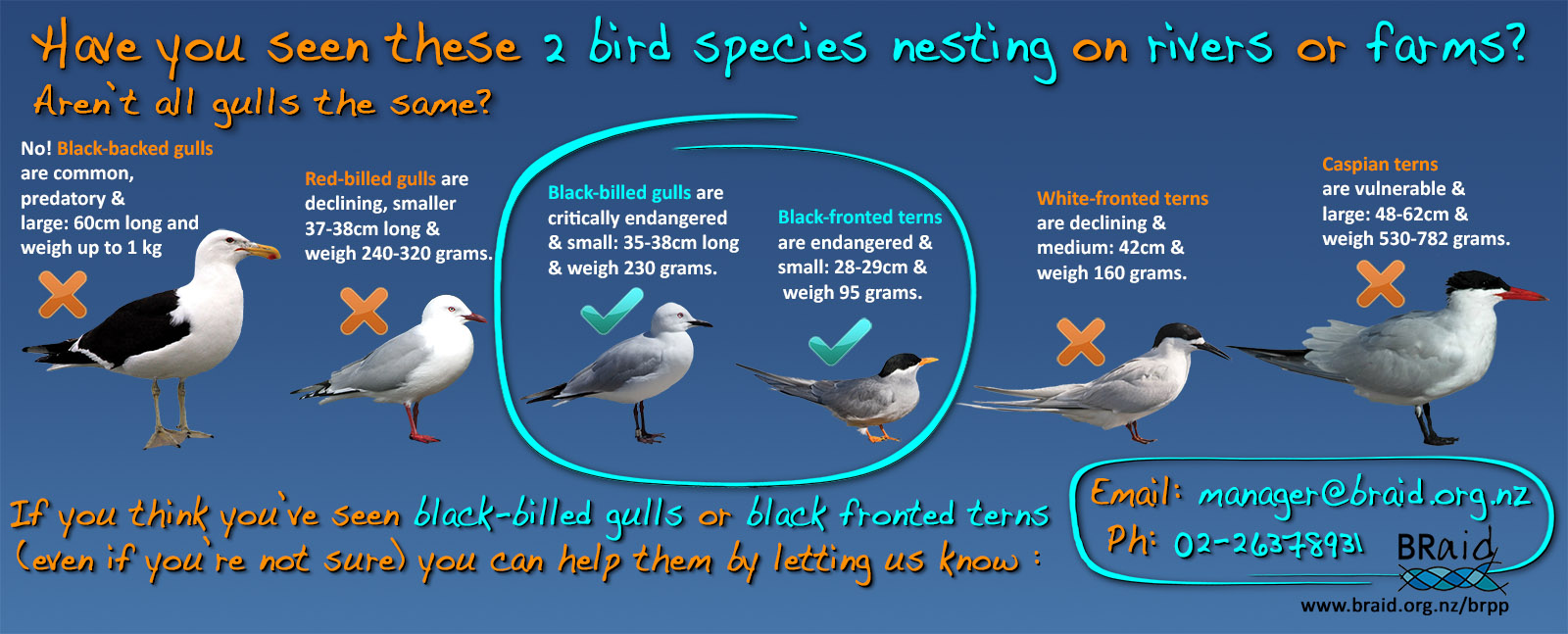Braided river birds: overview
More than 80 species of birds are found along braided rivers from the mountains to the sea. However, only 6 birds have evolved to live in this unique environment, and all are endemic, that is, they live only in New Zealand: black-billed gull | tarāpuka (endemic), black-fronted tern | tarapirohe, banded dotterel | pohowera, black stilt | kakī, South Island pied oystercatcher | tōrea, and wrybill | ngutupare.
The remaining 4 native species: Caspian tern | taranui, red-billed gull | tarāpunga, white-fronted tern | tara, and pied stilt | poaka have been included here because they are often mistaken for the endemic braided river birds, and in the case of pied-stilt | poaka, present a problem for the endemic black stilt | kakī for reasons that are explained on their respective pages.
All of these birds are taonga species for Ngāi tahu and as such, have special cultural, spiritual, historic, and traditional associations.
The populations of all braided river bird species are in decline; some are at risk of extinction.
Braided Rivers Seminar 2023 presentation
Which birds are found on what rivers
For the most recent data on bird numbers on different rivers, either go to each of the rivers on this website and check the section titled ‘bird surveys’.
You can also contact Miles Burford at Environment Canterbury for information on the database of bird counts. See this July 2023 presentation: Braided River Survey Data; Making use of a nationally important dataset (PDF).
Note that there are large gaps in the data. This is in part because: records are scattered, with many older records not digitalised; many remote areas have not been surveyed; some species such as black-billed gulls | tarāpuka are visible from the air during the breeding season as they nest in closely-spaced colonies, so aerial surveys can be regarded as reasonably accurate; small cryptic species such as wrybill | ngutupare and dotterels | pohoweraare are much harder and more labour intensive to count.
Important!
If you are monitoring or planning to monitor braided river birds, please first see the Department of Conservation PDF: ‘Protocol for best practice in monitoring braided river birds’.
Important notes relating to the PDF documents below
Below are links to short (3 to 7 page) PDFs that include maps, types of river birds on each river in the South Island, and threats. These were each extracted from the 2016 edition of Forest & Bird’s Important Areas For New Zealand Sea Birds: Sites on Land: Rivers and Estuaries (177 pages).
- The last known sightings or surveys were at the time of publication (2016).
- Braided river birds are migratory. Some species do not display site-fidelity; others do, but only of breeding conditions are optimal in the same place each year
- Most if not all braided river birds populations are dropping rapidly due to threats
North Canterbury rivers
Southland rivers
Fjordland rivers
References and research papers including areas outside the above-mentioned rivers
See Ecology/references or check each of the bird pages listed in the menu above.
- 2024: Crossland; Lower Heathcote-Ferrymead floodplain: Avian biodiversity status & management guidelines, CCC Parks Biodiversity Team
- 2023: O’Donnell, Braided river bird conservation: How far have we come over the last 40 years? PDF of seminar presentation
- 2023: Burford & Jack, Braided River Survey Data; Making use of a nationally important dataset (PDF)
- 2020: McCarthur et al., State and trends in the abundance and distribution of riverbed-nesting shorebirds on the Tutaekuri, Ngaruroro and Tukituki Rivers, Client report prepared for Hawke’s Bay Regional Council, Napier
- 2020: McCarthur; A review of significant coastal and freshwater habitats for indigenous birds in the Wellington region, report prepared for Greater Wellington Regional Council
- 2020: McCarthur; A review of the shorebird values and management actions in Hawke’s Bay Regional Council’s Ecological Management and Enhancement Plans
- 2020: McCarthur; A review of the status and management of banded dotterels (Charadrius bicinctus) on Ōnoke Spit, Client report prepared for the Department of Conservation, Masterton.

